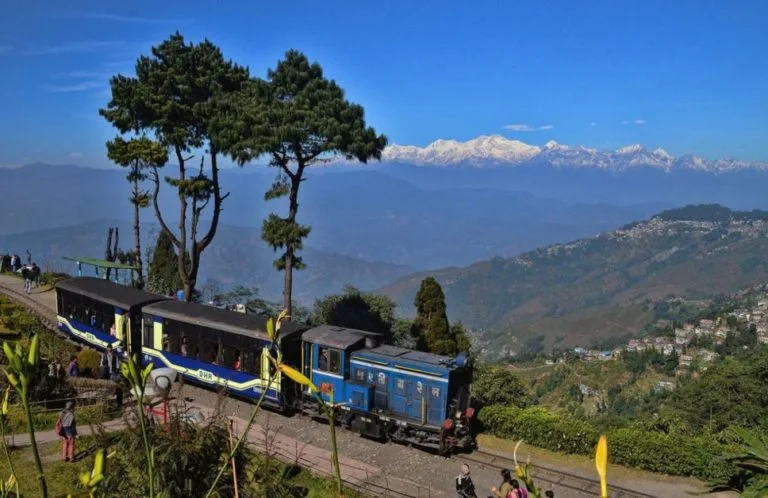Darjeeling's Colonial connection
The imprint of British architecture is visible at every nook and corner of Darjeeling, from the buildings, memorials, churches, parks, schools, clubs and more.
There are many reasons, which make Darjeeling a favourite destination for many tourists. Be it its colonial history or a haven for film-makers, where Rajesh Khanna in his jeep serenades Sharmila Tagore with the song, “Mere Sapno Ki Rani Kab Aayegi Tu…”, its tea industry, or the Darjeeling Himalayan Railway. There are plenty of reasons to include Darjeeling in one’s “must-visit” list. Located on the lesser Himalayan range, Darjeeling has its fair share of history. It was the abode of the British during summer, as they would come here to ward off the searing heat of their Capital, Kolkata. The imprint of British architecture is still visible at every nook and corner of the town ~from the buildings, memorials, churches, parks, schools, clubs and more ~ all somehow wear the colonial legacy. Our journey to the Darjeeling was a memorable one, from the time the plane landed at Bagdogra to when I left in a car for the hills. It was an around four-hour drive to Darjeeling, though the Google map showed it to be a two-hour journey. (Moral of the story: Don’t trust Google every time!)
Also read: Gangtok: a pristine land (travellernook.com)
Darjeeling Heritage Train
Our first encounter with the town began with the Darjeeling Heritage Toy Train. Its loud whistle could be heard far ahead of the main town. The traffic came to a halt for a while ~ they were, like us, patiently waiting for the train to pass. The moment the train crossed us we were reminded of some scenes from old and new Bollywood movies, including Burfi and Kahani. One thing that surprised us was the tracks ~ it was very narrow, just 2 feet. Built between 1879 and 1881 by British, the stretch from New Jalpaiguri to Darjeeling is 78 km. It runs from the lower plains all the way up to Ghoom at 7,407 ft (the highest point on any railway track in India) and then up to Darjeeling, and is considered to be an engineering ingenuity and a marvel. But owing to frequent landslides, most of this route is unusable today. Anyway, the fuming smoke and the shrill whistle of the steam engine not only makes the ride memorable but also nostalgic.
Also read: Manali: Stepping into abode of Gods (travellernook.com)
Colonial hotel
After having a first hand experience of the Toy Train, now it was time for another surprise. This time it was our hotel ~ Windamere Hotel. While checking into the hotel, Shubhana, the General Sales Manager told us this colonial heritage property and every room in it had some history connected. Here rooms are known by a name, not numbers. The room they provided us was named Rinzing Namgyal. I was told that Bollywood superstar Sharukh Khan too stayed in the same room for several nights during the shooting of the movie Main Hoon Na in 2004. Situated on the Observatory Hill in Darjeeling, the Windamere Hotel was established in the 19th century as a cosy boarding house for bachelor English and Scottish tea planters. The place was converted into a hotel just before the outbreak of the Second World War. The rooms are exactly the same as they were back then, with roaring coal fires, hot water bottles in the beds and huge closets (that housed everything that a tea planter would ever have needed for his stay). One is advised not to miss the afternoon tea, which is a world-renowned affair.
Tea Garden
No doubt Darjeeling has been the world's top tea producing place and known all over the world for the tea gardens producing "Champagne of Tea". There are many tea estate laid during the colonial days and still thriving. Many of them still have the original planters' bungalows with the old colonial charm and aura. After having a look at the abode of colonial tea planters, it was time to check their tea gardens. This led us to the Happy Valley Tea Estate, originally established by Wilson, an Englishman, in 1854. It was just 3 km away from Chowk Bazaar area but seeing the tea processing was an awesome experience. There were guides available to take us inside and show the entire tea production process. They produce variations like White tea, Green tea and Black tea. Most of the tea bushes in this estate are nearly 100 years old, some even older.
Also read: Odhisha: Hidden treasure in the East (travellernook.com)
Batasia Loop
Batisia Loop is another attraction of Darjeeling, which can’t be ignored. Located on Hill Cart Road, Batisia Loop was commissioned in 1919. Trust me, there is no better place to get a panoramic view of Darjeeling's landscape, including the hill town and the snow covered peaks of the Eastern Himalayas with the majestic Kanchenjunga on one side. And all this from the middle of a lovely garden with flowers, around which the toy train track is laid, compelling one to fish out the camera. At the centre of the Batasia Loop is the War Memorial, which was opened in 1995 to commemorate the Gorkha soldiers of the Darjeeling Hills, who sacrificed their lives in various wars after India's Independence.
Age-old restaurant
Not only the places, the century-old restaurants in Darjeeling are historic and came up during British time. One of them was Keventer, which was converted from Edward Keventer's dairy farm in Ghoom. The farm was once famous for its dairy and piggery products. Yes it has Bollywood connection also ~ the Ranbeer Kapoor starer Burfi was shot here. The other one is Glenary’s, which was founded by an Austrian named Pliva. It has the famous bakery and Tea Room on the ground floor and a multi-cuisine restaurant in the upper floor.
.png)
